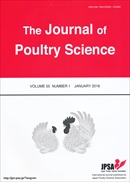55 巻, 3 号
選択された号の論文の10件中1~10を表示しています
- |<
- <
- 1
- >
- >|
Review
-
2018 年 55 巻 3 号 p. 163-171
発行日: 2018年
公開日: 2018/07/25
[早期公開] 公開日: 2018/02/25PDF形式でダウンロード (953K) HTML形式で全画面表示
Breeding and Genetics
-
2018 年 55 巻 3 号 p. 172-181
発行日: 2018年
公開日: 2018/07/25
[早期公開] 公開日: 2018/02/25PDF形式でダウンロード (2712K) HTML形式で全画面表示
Nutrition and Feeds
-
2018 年 55 巻 3 号 p. 182-189
発行日: 2018年
公開日: 2018/07/25
[早期公開] 公開日: 2018/02/25PDF形式でダウンロード (139K) HTML形式で全画面表示
(Research Note)
-
2018 年 55 巻 3 号 p. 190-194
発行日: 2018年
公開日: 2018/07/25
[早期公開] 公開日: 2017/12/25PDF形式でダウンロード (115K) HTML形式で全画面表示 -
2018 年 55 巻 3 号 p. 195-198
発行日: 2018年
公開日: 2018/07/25
[早期公開] 公開日: 2017/12/25PDF形式でダウンロード (323K) HTML形式で全画面表示
Anatomy and Histology
(Research Note)
-
2018 年 55 巻 3 号 p. 199-203
発行日: 2018年
公開日: 2018/07/25
[早期公開] 公開日: 2018/01/25PDF形式でダウンロード (1902K) HTML形式で全画面表示
General Physiology
-
2018 年 55 巻 3 号 p. 204-209
発行日: 2018年
公開日: 2018/07/25
[早期公開] 公開日: 2018/01/25PDF形式でダウンロード (546K) HTML形式で全画面表示
(Research Note)
-
2018 年 55 巻 3 号 p. 210-216
発行日: 2018年
公開日: 2018/07/25
[早期公開] 公開日: 2018/01/25PDF形式でダウンロード (1972K) HTML形式で全画面表示
Processing and Products
-
2018 年 55 巻 3 号 p. 217-223
発行日: 2018年
公開日: 2018/07/25
[早期公開] 公開日: 2018/01/25PDF形式でダウンロード (2356K) HTML形式で全画面表示 -
2018 年 55 巻 3 号 p. 224-231
発行日: 2018年
公開日: 2018/07/25
[早期公開] 公開日: 2018/02/25PDF形式でダウンロード (413K) HTML形式で全画面表示
- |<
- <
- 1
- >
- >|
